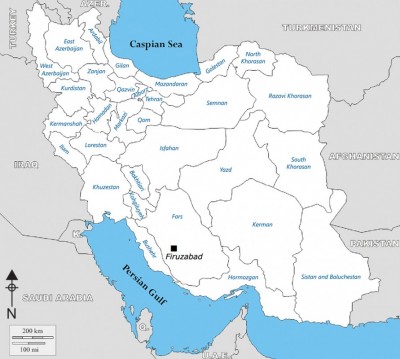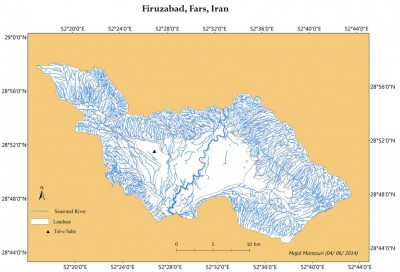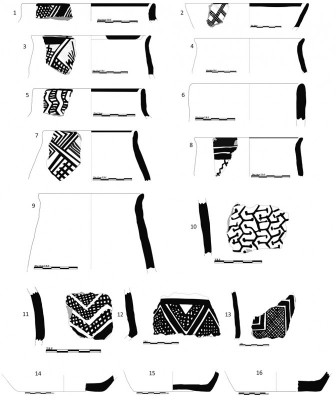Tol-e Sabz: a Neolithic site in the Firuzabad Plain, Fars, Iran
Introduction
The Firuzabad district is located in the western-central part of Fars province, Iran (Figure 1). The area is most famous for its historical monuments, including the City of Gur, the Palace of Ardashir, the Dokhtar Castle and a number of Sasanian rock reliefs. The first record of a prehistoric site (Tol-e Rigi) in this region was made by A. Stein back in 1934 (Stein 1936), but no further examples were located during surveys of the Firuzabad Plain by D. Huff (1973) or R. Noruzi (2005). In 2013, an archaeological survey directed by H. Ahmady was undertaken to identify Sassanian- and Islamic-period water-management systems on the plain. This survey discovered a prehistoric site, Tol-e Sabz, with typical Fars Neolithic ceramics. In this preliminary report, we introduce the site and consider its comparative chronology.
Tol-e Sabz
At c. 1325m above sea level, Tol-e Sabz (28° 51” 24” N and 52° 26” 47” E) is located in the north-west of the Firuzabad Plain, 2km south-east of the village of Baygan (Figure 2). The tell rises 4m above the surrounding plain and is almost 1.8ha in area (Figures 3 & 4). Stein visited the site in 1934, reporting only “a number of small, worked stone blades” on the slopes, but no ceramics other than some fragments of glazed ware on the top of the mound (Stein 1936: 129). In 2013, the authors visited the site and collected diagnostic ceramics and lithics. The distribution of the ceramics across the site was scant and prehistoric pottery was only recovered from the northern part of the site, which has been levelled by agriculture.
Ceramics
A total of 64 diagnostic sherds (23 rims, 36 bodies and 5 bases) was collected from the site (Figure 5). All of the ceramics were handmade with organic or organic-mineral temper. With the exception of five sherds, all of the pieces were well fired. Based on fabric and the colour of the painted decoration, the sherds can be divided into three groups: 1) red on red ceramics; 2) black on buff ceramics; and 3) simple red and buff ceramics. The first group (20 sherds) have a very pale red fabric with painted red decoration. Motifs include parallel bands, oblique ladders, intertwined lines, pair-lined lozenges and lozenges with a point inside. These decorative forms are best paralleled with Baši motifs (Bernbeck 2010: 65–151), although the lines are thicker than typical Baši examples (Table 1). The second group (32 sherds) are buff fabrics painted with black motifs: simple parallel bands, cross-hatched bands, lozenges, triangles and parallel bands with oblique lines. Some, but not all, of these motifs are very similar to those from Qasre Ahmad (Azizi & Khaluei 2011) and Jari A and B (Egami 1967; Egami et al. 1977; Maeda 1986). The third group (12 sherds) are simple red and buff ceramics comparable with those from Tol-e Nurabad (Potts & Roustaei 2006), Jari A and B (Egami 1967; Egami et al. 1977; Maeda 1986), Qasre Ahmad (Azizi & Khauei 2011) and Baši (Bernbeck 2010).
1: Vessel form; 2) manufacture; 3) firing; 4) fabric colour (ext. int. core.); 5) temper; 6) exterior coating. Colour; 7) interior coating colour; 8) decoration (ext. int.). Abbreviations: R (red); LR (light red); Bl (black); GB (greenish-buff); M (mineral); V (vegetal); VM (vegetal-mineral); U (unknown); H (hand); WF (well-fired); UF (under-fired).
Chipped stone tools
Ten chipped stone tools were collected from the northern part of the tell. The tools include blades, bladelets, an end scraper and flakes (Figure 6). All of them are made of chert and range in colour from light to dark brown. These lithics are mostly comparable with material from Muški (Fukai et al. 1973), Baši (Pollock et al. 2010) Rahmatabad (Azizi et al. 2013) and Kushke Hezar (Alden et al. 2004).
Conclusion
The ceramics of Tol-e Sabz indicate affinities with material from other Neolithic sites in the Fars province such as Qasr-e Ahmad, Baši, Nurabad and Jari A and B. Based on these parallels, Tol-e Sabz appears to have been occupied during the Muški–Baši period, late seventh and early sixth millennia BC.
Nevertheless, there are some decorative motifs that are currently only documented at Tol-e Sabz and that may therefore represent local forms. Alongside the evidence from other sites in the Kur River Basin (Fukai et al. 1973; Sumner 1977; Alden et al. 2004; Pollock et al. 2010; Ebrahimi et al. 2013), the Kazerun District (Sumner 1977), the valleys of Fasa and Darab (De Miroschedji 1973; Mansouri & Asadi 2013) and the Mamasani District (Potts & Roustaei 2006), it seems that cultural developments in the Ceramic Neolithic of Fars varied partially from valley to valley.
Acknowledgements
We are very grateful to Helen Taylor for reading the preliminary version of the article.
References
- ALDEN, J., K. ABDI, A. AZADI, F. BIGLARI & S. HEYDARI. 2004. Kushk-e Hezar: a Muški/Jari period site in the Kur River Basin. Iran 42: 25–45.
- AZIZI, H. & A. KHALUEI. 2011. Preliminary report of excavation at Qasre Ahmad, Fars province, unpublished report. Document and Archive Center of Iranian Center for Archaeological Research (in Persian).
- AZIZI, H., H. FAZELI & Y. NISHIAKI. 2013. Tepe Rahmat Abad: a pre-pottery and pottery Neolithic site in Fars province, in R. Matthews & H. Fazeli Nashli (ed.) The Neolithsation of Iran: the formation of new societies: 109–23. Oxford: Oxbow.
- BERNBECK, R. 2010. The Neolithic pottery, in S. Pollock, R. Bernbeck & K. Abdi (ed.) The 2003 excavations at Tol-e Baši, Iran: social life in a neolithic village (Archäologie in Iran und Turan Band 10). Berlin: Deutsches Archäologisches Institut.
- EBRAHIMI, S., M. ZARE, A. ABUALAHRAR & B. AMINPUR. 2013. Preliminary report of the third season of excavation at Tappeh Mian-Rud, in M. Hossein Azizi Kharanaghi, M. Khanipur & R. Naseri (ed.) Proceedings of the International Congress of Young Archaeologists, October, 2013: 87–98. Tehran: University of Tehran (in Persian).
- EGAMI, N. 1967. Excavations at two prehistoric sites: Tepe Djari A and B in the Marv Dasht Basin, in A.U. Pope & Ph. Ackerman (ed.) A survey of Persian art from prehistoric times to the present (XIV): 2936–39. Shiraz: Asia Institute of Pahlavi University.
- EGAMI, N., S. MASUDA & T. GOTOCH. 1977. Tal-i Jarri A: a preliminary report of the excavations in Marv Dasht, 1961 and 1971. Orient 8: 1–14. http://dx.doi.org/10.5356/orient1960.8.1
- FUKAI, S., H. KIYOHARU & M. TOSHIO. 1973. Marv-Dasht III: the excavation at Tall-i-Muški, 1965. Tokyo: Institute of Oriental Culture, University of Tokyo.
- HUFF, D. 1973. An archaeological survey in the area of Firuzabad, Fars. Proceedings of the 2nd Annual Symposium on Archaeological Research in Iran 1973: 155–79.
- MAEDA, A. 1986. A study of the painted pottery from Tape Djari B. Bulletin of the Ancient Oriental Museum 8: 55–86.
- MANSOURI, M. & A. ASADI. 2013. Archaeological survey of the prehistoric sites of the Fasa district, Fars, Iran. Payam Bastanshenas 2: 1–16 (in Persian).
- DE MIROSCHEDJI, P. 1973. Prospections archéologiques dans les vallées de Fasa et de Darab: rapportpréliminaire: 1–13. Tehran: Ministry of culture and arts, National research centre for history of art and archaeology.
- NORUZI, R. 2005. Archaeological survey in the Firuzabad, Research and Cultural Institute of Encyclopedia of Fars province. Shiraz: Iranian Cultural Heritage Organization of Fars (in Persian).
- POLLOCK, S., R. BERNBECK & K. ABDI. 2010. The 2003 excavations at Tol-e Baši, Iran: social life in a neolithic village (Archäologie in Iran und Turan Band 10). Berlin: Deutsches Archäologisches Institut.
- POTTS, D.T. & K. ROUSTAEI. 2006. The Mamasani archaeological project stage one: a report on the first two seasons of the ICAR-University of Sydney joint expedition to the Mamasani District, Fars province, Iran. Tehran: Iranian Center for Archaeological Research.
- STEIN, A. 1936. An archaeological tour in the ancient Persis. Iraq 3: 111–225.
- SUMNER, W.M. 1977. Early settlements in Fars province, Iran, in L.D. Levine & T.C. Young, Jr. (ed.) Mountains and lowlands: essays in the archaeology of Greater Mesopotamia: 291–305. Malibu (CA): Undena.
Authors
* Author for correspondence.
- Majid Mansouri *
University of Tehran, Faculty of Literature and Human Science, Department of Archaeology, Enghelab Street, Tehran, Iran (Email: m.mansouri@ut.ac.ir) - Hesamalddin Ahmady
Art University of Isfahan, Faculty of Conservation and Restoration, Department of Archaeology, Hakim Nezami Street, Isfahan, Iran (Email: ahmadi.hesamalddin@yahoo.com)








 Cite this article
Cite this article